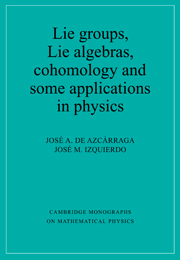Book contents
- Frontmatter
- Contents
- Preface
- 1 Lie groups, fibre bundles and Cartan calculus
- 2 Connections and characteristic classes
- 3 A first look at cohomology of groups and related topics
- 4 An introduction to abstract group extension theory
- 5 Cohomology groups of a group G and extensions by an abelian kernel
- 6 Cohomology of Lie algebras
- 7 Group extensions by non-abelian kernels
- 8 Cohomology and Wess-Zumino terms: an introduction
- 9 Infinite-dimensional Lie groups and algebras
- 10 Gauge anomalies
- List of symbols
- References
- Index
2 - Connections and characteristic classes
Published online by Cambridge University Press: 08 February 2010
- Frontmatter
- Contents
- Preface
- 1 Lie groups, fibre bundles and Cartan calculus
- 2 Connections and characteristic classes
- 3 A first look at cohomology of groups and related topics
- 4 An introduction to abstract group extension theory
- 5 Cohomology groups of a group G and extensions by an abelian kernel
- 6 Cohomology of Lie algebras
- 7 Group extensions by non-abelian kernels
- 8 Cohomology and Wess-Zumino terms: an introduction
- 9 Infinite-dimensional Lie groups and algebras
- 10 Gauge anomalies
- List of symbols
- References
- Index
Summary
This chapter is devoted to describing the elements of the theory of connections on principal bundles and a few of their physical applications, including the Yang-Mills theories, the Wu-Yang description of the monopole, and SU(2)-instantons. These, and further applications to gauge anomalies that will be made in chapter 10, motivate the sections dealing with characteristic classes. The chapter also includes an elementary discussion of some index theorems, of importance in the theory of gauge anomalies.
Connections on a principal bundle: an outline
A geometrical object such as a vector is moved by parallel transport on a manifold M if its components with respect to a parallelly transferred frame are kept constant. But how is the parallel transport of frames defined? We saw in section 1.3 that it is convenient to look jointly at the manifold M and at the set of all frames rx (bases of Tx(M)) at the different points x ∈ M as the bundle of linear frames L(M)(GL(n, R)(M). However, given the frame bundle L(M) there is no canonical way of relating a certain frame rx at a point x ∈ M to another frame rx′ at another point x′ ∈ M or, in other words, given a curve on the base manifold M, starting at x ∈ M, there is no intrinsic way of lifting it to a curve in L(M) starting at a certain p ∈ L(M) over x, π(p) = x.
- Type
- Chapter
- Information
- Publisher: Cambridge University PressPrint publication year: 1995

